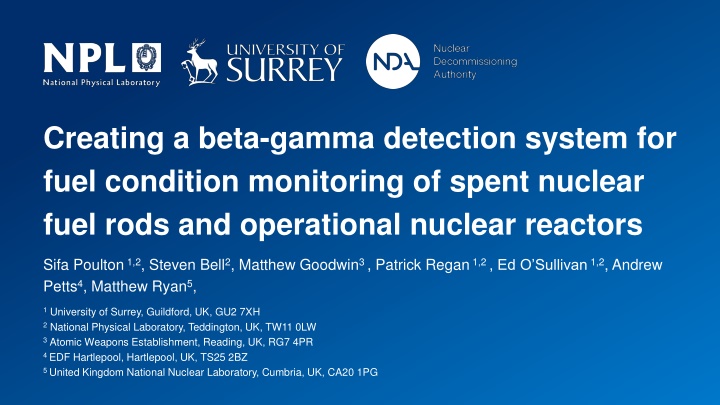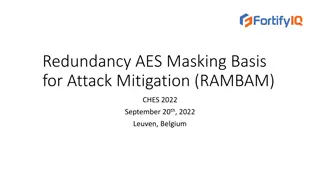
Beta-Gamma Detection System for Nuclear Fuel Monitoring
"Explore the development of a beta-gamma detection system for monitoring nuclear fuel conditions in spent fuel rods and operational reactors. Motivations include nuclear fission, fuel pin failure investigations, and decommissioning efforts in the nuclear industry."
Download Presentation

Please find below an Image/Link to download the presentation.
The content on the website is provided AS IS for your information and personal use only. It may not be sold, licensed, or shared on other websites without obtaining consent from the author. If you encounter any issues during the download, it is possible that the publisher has removed the file from their server.
You are allowed to download the files provided on this website for personal or commercial use, subject to the condition that they are used lawfully. All files are the property of their respective owners.
The content on the website is provided AS IS for your information and personal use only. It may not be sold, licensed, or shared on other websites without obtaining consent from the author.
E N D
Presentation Transcript
Creating a beta-gamma detection system for fuel condition monitoring of spent nuclear fuel rods and operational nuclear reactors Sifa Poulton1,2, Steven Bell2, Matthew Goodwin3 , Patrick Regan1,2 , Ed O Sullivan1,2, Andrew Petts4, Matthew Ryan5, 1 University of Surrey, Guildford, UK, GU2 7XH 2 National Physical Laboratory, Teddington, UK, TW11 0LW 3 Atomic Weapons Establishment, Reading, UK, RG7 4PR 4 EDF Hartlepool, Hartlepool, UK, TS25 2BZ 5 United Kingdom National Nuclear Laboratory, Cumbria, UK, CA20 1PG
Motivation Nuclear Fission and Nuclear Fuel Condition monitoring
Motivation Nuclear Fission and Nuclear Fuel Condition monitoring Active power plants
Motivation Nuclear Fission and Nuclear Fuel Condition monitoring Fuel storage Active power plants
Motivation Nuclear Fission and Nuclear Fuel Condition monitoring Investigating fuel pin failures Fuel storage Active power plants
Motivation Decommissioning/ clean up Nuclear Fission and Nuclear Fuel Condition monitoring Investigating fuel pin failures Fuel storage Active power plants
Motivation Decommissioning/ clean up Weapons test monitoring Nuclear Fission and Nuclear Fuel Condition monitoring Investigating fuel pin failures Fuel storage Active power plants
Motivation Where is beta-gamma coincidence gas counting useful? Fuel storage Decommissioning/ clean up Active power plants Weapons test monitoring Investigating fuel pin failures
Motivation Where is beta-gamma coincidence gas counting useful? Fuel storage Decommissioning/ clean up Active power plants Weapons test monitoring Investigating fuel pin failures
Motivation Where is beta-gamma coincidence gas counting useful? Fuel storage Decommissioning/ clean up Active power plants Weapons test monitoring Investigating fuel pin failures
Motivation Where is beta-gamma coincidence gas counting useful? Fuel storage Decommissioning/ clean up Active power plants Weapons test monitoring Investigating fuel pin failures
Why use noble gases? Chemically unreactive Relatively abundant fission fragment Isotopic ratio produced depends on reaction conditions Taken from Koehl, M. (2016). Relative fission product yield determination in the USGS TRIGA Mark I reactor.
Which xenon isotopes? Isotopes: 133Xe, 135Xe 131mXe 133Xe 133mXe 135Xe Metastables: 131mXe, 133mXe half-life 11.84 (4) d [1] 5.2475 (5) d [2] 2.198 (13) d [2] 9.14 (2) h [3] Goldilocks half-lives Decay (keV) 163.930 (8) [1] 80.9979 (11) [2] 233.221 (15) [2] 249.794 (15) [3] endpoint (keV) - 346.4 (24) [4] - 905.1 (40) e- emission (keV) 129.366 (8) [4] 45.0133 (11) [4] 198.655 (15) [4] 492.006 (5) [4] X-ray (keV) 39.5-34.6 [4] 30.6-35.9 [4] 29.5-34.5 [4] 30.6-36.0 [5] [1] NDS 107,2715 (2006) [2] NDS 112,855 (2011) [3] NDS 109,517 (2008) [4] BIPM Table of Radionuclides, vol. 8 (2016) [5] M. Galan J. Env. Rad. (2018)
Factors affecting ratio Fuel type Energy of neutrons Reaction rate Adapted from Kalinowski, M.B., Axelsson, A., Bean, M. et al. Discrimination of Nuclear Explosions against Civilian Sources Based on Atmospheric Xenon Isotopic Activity Ratios. Pure Appl. Geophys. 167, 517 539 (2010).
Detector test set up PIPSBox 2x1200-500PA comprising two silicon detectors either side of a gas volume [6] for beta detection A single GEM-SP9430-LB-C-HJ-S HPGe [7] for gamma measurement Digitiser: CAEN DT5780M 2 channel digitiser [8] with DPP-PHA firmware [9] PIPSBox preamp: CAEN A1422 4 channel [10] HPGe preamp: [6] Mirion Technologies (2023) [9] Caen Instrumentation (2023) [7] Ortec/Ametek (2024) [10] Caen Instrumentation (2022) [8] Caen Instrumentation (2024)
Mixed gas source 3 Bq 0.5 Bq
HPGe Odin singles Taken from Poulton, S.E., et al.,2025. Progress toward electron-photon coincidence detection of noble gases for enhanced safety monitoring of nuclear fuel. Radiation Physics and Chemistry, p.112703.
HPGe Odin singles 133Xe 81 keV Taken from Poulton, S.E., et al.,2025. Progress toward electron-photon coincidence detection of noble gases for enhanced safety monitoring of nuclear fuel. Radiation Physics and Chemistry, p.112703.
PIPSBox singles 131mXe 130 keV CE 131mXe 160 keV CE Taken from Poulton, S.E., et al.,2025. Progress toward electron-photon coincidence detection of noble gases for enhanced safety monitoring of nuclear fuel. Radiation Physics and Chemistry, p.112703.
Taken from Poulton, S.E., et al.,2025. Progress toward electron-photon coincidence detection of noble gases for enhanced safety monitoring of nuclear fuel. Radiation Physics and Chemistry, p.112703.
Gated gamma 35 < E < 430 115 < E < 145 35 < E < 115 145 < E < 430 Adapted from Poulton, S.E., et al.,2025. Progress toward electron-photon coincidence detection of noble gases for enhanced safety monitoring of nuclear fuel. Radiation Physics and Chemistry, p.112703.
What next? Experiment at EDF Hartlepool Higher count efficiency set-up 2 HPGes (one BEGe), 1 NaI, and use 2 PIPS channels Real world scenario Gas from the reactor core Higher activity rate More species
Acknowledgements SEP is funded by a PhD Bursary from the United Kingdom Nuclear Decommissioning Authority, managed by the United Kingdom National Nuclear Laboratory PHR received funding from the Science and Technology Facilities Council via Grant Nos. ST/L005743/1 and ST/P005314 This work is also supported by UK Government Department of Business, Energy, and Industrial Strategy via the National Measurement System

